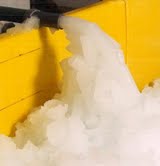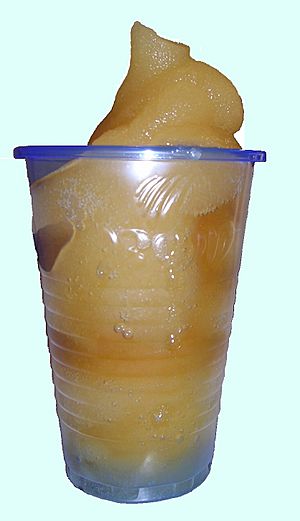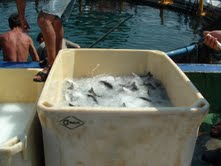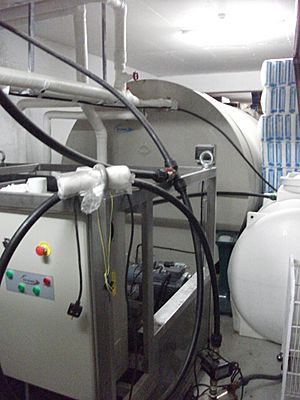Pumpable ice technology facts for kids
Pumpable ice is a cool new technology. It uses thin liquids that can cool things down just like regular ice. Think of it as a slushy mix of tiny ice crystals. These crystals are super small, from the size of a speck of dust to about 1 centimeter. They float in liquids like salty water, food liquids, or even air bubbles.
Contents
- What We Call Pumpable Ice
- How Pumpable Ice Is Made
- What Pumpable Ice Is Used For
What We Call Pumpable Ice
People use many different names for this special ice. Some common names are "pumpable ice," "jelly ice," or "slurry ice." Companies also have their own brand names, like "Deepchill," "Beluga," or "Flow Ice." These names are used by companies that make ice machines in many countries around the world.
How Pumpable Ice Is Made
Pumpable ice can be made in two main ways.
- The first way is to take regular solid ice (like the ice cubes you use) and crush it. Then, you mix it with water. This creates a slushy mix with different amounts of ice and various crystal sizes. This mix is then pumped from a storage tank to wherever it's needed.
- The second way is to make the ice crystals directly inside the liquid you want to cool. This can be done using special vacuum technology or cooling methods.
* With vacuum technology, the pressure is made very low. This causes a small part of the water to evaporate, and the rest of the water freezes into an ice-water mix. This method is good for very large cooling systems. * Making ice by cooling can be done in two ways: direct or indirect.
Direct Cooling for Pumpable Ice
In direct cooling, a special cooling liquid (called a refrigerant) is put right into the liquid you want to freeze. This sounds simple because there's nothing in between the refrigerant and the liquid. But it can cause problems. You need to be very careful with safety, separate the refrigerant later, and it can be hard to make the right kind of ice crystals.
Indirect Cooling for Pumpable Ice
Indirect cooling is different. The liquid flows through special tubes inside a machine called an evaporator. This evaporator has a cold wall that cools the liquid. As the liquid gets super cold, tiny ice crystals start to form on the cold wall.
A special part, like a whip or a screw, scrapes these ice crystals off the wall. This stops the ice from sticking and growing too thick. This method is very good because it uses less energy to make ice. For example, it can make 1,000 kg of ice using much less electricity than making regular ice.
Sometimes, gas is added to the liquid flowing through the evaporator. This helps the liquid mix better and makes the pumpable ice flow more easily.
Many different liquids can be used, like seawater, juice, or special salty solutions. The equipment usually includes an ice maker, a storage tank, pumps, and other electronic parts.
Pumpable ice can have up to 40% ice when it leaves the ice maker. In a storage tank, it can reach 50% ice. Special mixers are used in the tanks to keep the ice from separating from the liquid. This allows the ice to be pumped long distances.
However, large storage tanks can have issues. Sometimes, the ice forms big chunks or uneven ridges. This can stop the cooling system from working well. Scientists are working on new designs to fix these problems and make storage tanks even better.
What Pumpable Ice Is Used For
Many companies and scientists are working on pumpable ice technology. It's very energy-efficient and takes up less space. This means it has many uses!
Choosing the Right System
If you want to use pumpable ice, you need to think about a few things:
- How much cooling power you need.
- When you will need the cooling (day, week, year).
- What temperature your products (like food or fish) need to be.
- The weather conditions where you are.
- How much space you have for the equipment.
- Your plans for the future.
When designing storage tanks, remember:
- If the ice will touch food directly, you need a mixer in the tank. This keeps the ice from freezing into a big block and helps it flow through pipes.
- Consider the space you have for the tanks (tall or wide).
- Plan for a bit more stored energy than you think you'll need.
Keeping It Working Well
Pumpable ice makers need regular care and cleaning. Good maintenance helps the machine last longer and prevents big problems.
If you don't maintain the equipment, you might see issues like:
- Fans failing because dirty coils block airflow.
- The cooling system working harder and using more electricity.
- Parts overheating or breaking down.
- Water lines getting blocked.
It's important to clean the liquid before it enters the ice maker. This stops dirt from building up and keeps the system working smoothly.
Cleaning Wastewater
Pumpable ice technology can even help clean dirty water! It works by freezing the water, then letting it melt. This changes the structure of the dirt particles, making them easier to separate from the clean water. It doesn't need any harsh chemicals. The cleaned water can then be used for farming or industry.
Making Drinking Water from Seawater
Making fresh water from seawater is called desalination. Freezing seawater to remove the salt has some good points: it uses less energy, causes less rust, and doesn't create as much mineral buildup. The challenge has been handling the ice and water mix. Pumpable ice machines offer a new way to do this efficiently, especially for smaller needs.
Concentrating Juices and Food Liquids
Right now, juices are often concentrated using heat. But this can damage the flavor and smell of the juice. Using cooling and freezing to concentrate juices is a better way. When juice is frozen, pure water turns into ice crystals, leaving the flavor, color, and smell in the concentrated juice. This method keeps the quality of the product very high. It also uses less energy and makes it easier to separate the concentrated juice from the ice.
Making Frozen Drinks and Ice Cream
Frozen drinks like slushies and ice cream are very popular. The way they are made is quite similar to how pumpable ice is produced.
Frozen Carbonated Beverages
Frozen carbonated beverages (like frozen Coke) were invented in the 1950s. They are made by mixing flavored syrup, carbon dioxide gas, and water. This mix goes into a cold machine where it freezes on the inside surface. Blades then scrape off the ice, creating a thick slushy drink. The machine keeps a little pressure inside to help the gas mix with the liquid. The final product is a thick mix of ice crystals and a small amount of liquid.
Frozen Uncarbonated Beverages
These are like frozen carbonated drinks but without the fizz! They are made from fruit juices, coffee, tea, or yogurt. Scientists are even looking into making frozen wine and beer. These machines are simpler and cheaper than the carbonated ones because they don't need gas or special pressure. They often have less ice and more liquid than frozen carbonated drinks.
Ice Cream
Ice cream is a huge market around the world! Making ice cream involves several steps, including mixing and freezing. The ice cream mix goes into a special freezer where it gets very cold. Ice crystals form on the cold walls and are scraped off by blades. These blades also whip air into the mix, making the ice cream smooth and creamy.
The quality of ice cream depends on how small and smooth the ice crystals are. Faster freezing creates more tiny crystals, which makes for better ice cream.
Fishery and Food Industry
Pumpable ice is great for cooling fish and other foods. It has several advantages over regular ice:
- It's smooth and flows like water, so it doesn't damage the food.
- It cools food faster and more evenly.
- It helps food stay fresh longer.
- It meets important food safety rules.
- It uses less energy than traditional ice.
Supermarkets
Supermarkets can use pumpable ice to cool their display cases. Instead of using harmful cooling chemicals, pumpable ice circulates through the pipes.
Here's why it's good for supermarkets:
- The equipment is smaller and takes up less space.
- It cools things very well.
- It keeps a steady temperature inside the display cases.
- It makes the cooling system more flexible, so cases can be moved easily.
- It needs less piping and is cheaper to install and fix.
- It uses less energy for defrosting the cases.
- It doesn't produce heat under the cabinets, keeping the air around them cooler.
Making Ice Wine
Pumpable ice can help make a special type of wine called "ice wine." Normally, grapes for ice wine have to freeze on the vine for months. But with pumpable ice, freshly squeezed grape juice can be pumped through a machine. This machine creates tiny, pure ice crystals and a more concentrated juice. The process is repeated until the juice is very sweet. Then, it's fermented into this unique alcoholic drink.
Storing Energy
Pumpable ice can be used in systems that store energy, especially for air conditioning in large buildings. The idea is to make and store pumpable ice when electricity is cheaper (like at night). Then, during busy times when electricity is expensive, the stored ice is used to cool the building. This saves money on electricity bills and helps the environment by reducing energy use and pollution. These systems are already used in many countries.
Medicine
Pumpable ice is also being explored for medical uses. A special ice slush can be injected into arteries or veins, or used on the outside of organs during surgery. It can quickly cool down organs to protect them from damage after a stroke or heart attack.
The benefits in medicine include:
- It can be pumped easily through small tubes, cooling organs quickly and precisely.
- It helps protect organs during surgery.
- It can help people who have medical emergencies like cardiac arrest or stroke.
Ski Resorts
Ski resorts are interested in pumpable ice to make snow, even when it's not very cold outside (up to 20°C!). Traditional snow-making needs temperatures below -4°C.
With pumpable ice, a salty solution is put under very low pressure. Some of the water evaporates, and the rest freezes into an ice-liquid mix. This ice is then separated and can be used to make snow. This technology allows skiers to train for longer periods, even before and after the winter season. It's already being used at ski resorts in Austria and Switzerland.








